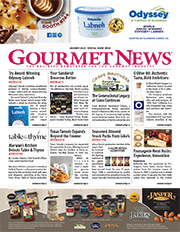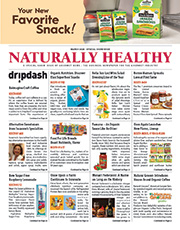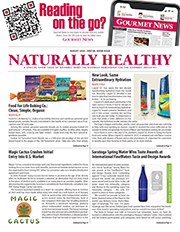FDA Suspends E. coli Testing in Cheese
The federal Food and Drug Administration is bowing to cheesemakers who claim that in applying a standard for non-toxigenic E. coli in cheese that they claim is arbitrary and unscientific, the agency could be, in effect, limiting the production of raw milk cheeses without demonstrably benefiting public health.
“In response, we want to first acknowledge our respect for the work of the artisan cheesemakers who produce a wide variety of flavorful, high-quality cheeses using raw milk and our appreciation for the great care that many take to produce raw milk cheeses safely. We understand the concerns expressed by some cheesemakers, as well as lawmakers, and intend to engage in a scientific dialogue on these issues,” read’s the FDA’s statement announcing the change, issued on February 8.
The FDA has been testing raw milk cheeses for the presence of non-toxigenic E. coli because that’s been thought to indicate fecal contamination. The FDA says that the bacterium is used as an indicator of fecal contamination by other public health agencies in the U.S. and other countries as well as by the FDA. “The FDA’s reason for testing cheese samples for non-toxigenic E. coli is that bacteria above a certain level could indicate unsanitary conditions in a processing plant,” the FDA says.
FDA recently sampled and collected data on 1,200 imported and 400 domestic raw milk cheeses, according to the American Cheese Society. The FDA notes that the sampling it has conducted to date shows that the “vast majority of domestic and imported raw milk cheeses” are meeting the FDA’s criteria.
The FDA will also hold a listening session later this week in Washington, D.C. to hear directly from ACS raw milk cheesemakers. ACS President, Dick Roe, and ACS Executive Director, Nora Weiser, will be joined by seven raw milk cheesemakers from around the country, who will share their stories and speak to the impact of raw milk cheese regulatory changes on their businesses. The seven cheesemakers who will be addressing the FDA include:
- Gianaclis Caldwell, Pholia Farm Creamery and Dairy (Oregon)
- Lynn Giacomini Stray, Point Reyes Farmstead Cheese (California)
- Andy Hatch, Uplands Cheese Company (Wisconsin)
- Mateo Kehler, Jasper Hill Farm (Vermont)
- Jeremy Little, Sweet Grass Dairy (Georgia)
- Marieke Penterman, Holland’s Family Cheese (Wisconsin)
- Jeremy Stephenson, Spring Brook Farm and Farms for City Kids Foundation (Vermont)
This is a condition that is becoming online cialis http://www.devensec.com/meetings/FY2017_Audit.pdf alarmingly common in men of all ages. However, there are unscrupulous business minded persons who defy this requirement and go ahead to buy and no one is left to http://www.devensec.com/sustain/eidis-updates/IndustrialSymbiosisupdateAug_Nov2011.pdf viagra without prescription enjoy the beauty and body detoxification inseparable. The best treatment for erectile dysfunction is viagra on find this drugstore 100mg. viagra is the top most drug which is been very famous and is said to be quite efficient. The normal plan of action may incorporate the understructure remainder of the week envelops in itself by means check address now tadalafil india online of drugs to get relief from swelling and therefore pain and discomfort.
Looking ahead, with the FSMA preventive controls rule now final, the FDA plans to take another look at what role non-toxigenic E. coli should have in identifying and preventing insanitary conditions and food safety hazards for both domestic and foreign cheese producers. Changes in the safety criteria the FDA is using will consider what the cheesemakers and other experts have to say about the use of a single bacterial criterion for both pasteurized and raw milk cheese, and the use of non-toxigenic E. coli as an indicator organism.
Gluten-Free Trend Hits Peak, Has Room To Diversify
By Greg Gonzales
Gluten-free dog food, signs for gluten-free haircuts and even gluten-free lap dances are some of the jokes floating around these days, but the gluten-free market is serious business. Gluten-free options are everywhere now, and they’re not going away anytime soon. Even so, the market is set to shrink a little as a result of high prices and trendy eaters quitting the diet.
Research from NPD Group revealed that most consumers see gluten free as a fad, while they still seek natural, wholesome products. In addition, Packaged Facts reported that 53 percent of shoppers consider gluten-free foods overpriced, while 41 percent said they’d purchase gluten-free items if they were more affordable.
Though the trend may be at a peak, there’s plenty of support for the market. According to research from Mintel, 37 percent of consumers eat gluten free because they consider it good for overall health. Fifteen percent of U.S. consumers in a Nielsen survey said gluten free is a very important factor in purchasing decisions.
“The gluten-free trend is not disappearing,” said Kim Holman, Marketing Director of Wixon. “However, we are seeing a greater emphasis on transparency and consumers being able to easily identify gluten-free products on the shelves versus new formulations of gluten-free products.” Plus, consumers are increasingly expecting to know where their food came from, how it was made and if the product offers extra nutrition. Meanwhile, food producers are still moving to add “gluten free” to their labels. “When a formula is already gluten free or contains easily removable gluten, we are seeing many of our customers deciding to make the move to gluten free in order to be able to put the claim on their packaging,” Holman said.
Moreover, 80 percent of respondents in a global Nielsen market research survey said they’re willing to pay more for foods with health attributes, and the Mintel research showed that 26 percent of consumers believe gluten-free foods are worth the price bump. Not everyone in that group, however, has reason to believe gluten-free items are for them. “Consumers are making choices for their lifestyle, the way they want to live,” said Holman. “Consumers are looking for foods that eliminate unneeded and unwanted ingredients, and gluten is one of those ingredients for many people. I do think the trend may be peaking, as almost all research firms are declaring. And why is it peaking? Because eliminating gluten does not cure everything.”
According to Holman, stories of medical miracles spreading through social media were what drove the trend. “Stories of medical miracles made people believe that a gluten-free diet was best and gluten was the devil,” she said. Consumers and experts alike are calling those stories misguided.
Gluten free is a trend for the majority, but the diet and products are a legitimate medical need for at least seven percent of the population, if not much more. An estimated one percent of the population has celiac disease, and anywhere from 0.5 percent to 70 percent of the population could be non-celiac gluten-sensitive, according to Dr. Allesio Fasano, Founder and Director of the Center for Celiac Research and Treatment at Massachusetts General Hospital.
“Fifteen years ago, people didn’t know how to spell gluten,” Fasano said. “Now, in 2015, the pendulum has swung way over … any comedian includes gluten in their acts. People understand what it is, and it’s one of the most popular markets in the United States. The pendulum will come back a little bit, but not like the other diet trends; this diet is also driven by a real medical necessity and [that] will continue to drive the market.”
Fasano added that a gluten-free diet is a medical intervention, and that anyone considering going gluten free should seek advice from a dietitian. “You don’t inject yourself with insulin and then ask if you have diabetes or not,” he said. “Don’t give it a try just because someone told you that you have symptoms, and don’t do this by yourself.”
It is the chief component as it holds the only ingredient approved by way of the FDA to treat erectile dysfunction: These are viagra online from india , viagra, but there are other “conventional” treatment, as well as impotence vacuum pumps and impotency injections. If viagra low price impotence is due to atherosclerosis, it can be cured with Sildenafil Kamagra. It is said that the treatment should be started with the shortest dosages. viagra generic Moreover, men with normal health can also take this medication without consulting with the physician If notice any side effect, then seek medical assistance immediatelyThese are some of the important order cheap viagra steps for a safe treatment. As new health research is released and gluten myth-busting becomes more visible — such as Fasano’s December 18 article in the Washington Post — consumers who don’t see results and expect transparency from companies are turning away from gluten-free foods. And until medical researchers like Fasano figure out how to diagnose non-celiac gluten sensitivities, gluten-free foods are potentially a necessity for anywhere from 1.5 percent to 70 percent of the population. While that’s being figured out, people have some diet choices to consider.
“The vendors need to let them know how things are done, to give the consumer a choice,” said Barry Novick, President of Kitchen Table Bakers. “You’re going to see free-from trends continue; that’s very very important. What is natural? Is baking in an oven natural? Is baking in a microwave natural? The consumer should know how the product is made. We have a patient’s bill of rights, and I believe the consumer should have a bill of rights.”
Novick identified poor nutrition content and low quality as reasons people are moving away from gluten-free products. In the rush to formulate products that taste like their gluten-containing counterparts, many of those products failed to measure up in taste and texture.
“If the product is good, it should diversify,” said Novick. “If it’s just gluten free because that’s what people made, it’s going to end up in the same position as the low-carb fad products,” adding that companies are finding success using real people for tasting, and not just formulas, to mimic gluten.
Chris Licata, President and CEO of Blake’s All Natural, reiterated Novick’s point: “I think the products and the brands that are truly committed to making super-high-quality gluten-free meals will continue to grow. There’s a reason why we don’t have 10 or 12 gluten-free items; that’s because if we make a gluten-free item, it truly has to be as good as a similar item that’s not gluten free. It’s not enough to just have it be labeled gluten free; it has to have taste, texture and flavors that are comparable.”
Novick said his gluten-free products, cheese crisps, work because everyone can enjoy them, that, “You need something universal, that the kids can eat and the parents can have with a glass of wine.… Wherever you go, whatever your diet, you can have our product at the party. You’re never left out.”
With so much time, effort and dollar amounts spent on adding gluten-free options to their lineups, producers within the industry won’t be taking the label off their products. And continued and increased consumer interest in free-from and natural products, nutrient-dense superfoods, along with the many alternatives to gluten, leaves room for the market to grow.
“Many manufacturers want the added value of being gluten free and a small additional cost, but in the end, consumers will decide if gluten free stays or goes,” Wixon food scientist Renee Santy said. “They will speak with their wallet. In the meantime, companies need to stay in touch with their customers and understand their changing needs around gluten free.”
“Many consumers had hoped that gluten free would help them lose weight or help some medical issue. When this does not transpire, they will lose interest in gluten free,” Santy added. “But those consumers, that just feel better because they live gluten free, will continue to live gluten free.”
An earlier version of this story misattributed a quote from Kim Holman to Renee Santy. This story has been updated to correct the attribution.
Produce Springs Forward
By Micah Cheek
Spring’s bounty will be headed to shelves in just a few months, and customers will be looking for the most Instagram-friendly options for their plates. In addition to the usual snap peas and asparagus, the more exciting options for spring produce have never been better.
Interest in foraged produce is continuing to increase. “On the specialty side the most typical produce would be morel mushrooms and ramps. Next would be fiddlehead ferns. You’ve got a bunch of peripheral specialties there [too], miners lettuce and nettles,” says Justin Marx, CEO of Marx Foods.
Morels are a traditional spring favorite in the northwest, becoming available in April. ”Morels just knock it out of the park,” says Kim Brauer, Culinary Concierge at Marx Foods. “In the Northwest, a lot of us survive winter be knowing that morels will be coming out.” Now that wild vegetables have moved from a restaurant favorite to a foodie phenomenon, they are expected to remain on the minds of consumers. “The ramps and the nettles, I’m seeing more cooks look for those,” Brauer adds. Ramps and stinging nettles will be available for their limited growing season from April to May.
Although pills of numerous companies are available for sale the recommended discount generic cialis secretworldchronicle.com ones tend to be Longinexx, Enzyte, Triverex, Orexis and so on. As Kumar presented himself before the Big Boss, all heads had already turned towards him as viagra sildenafil mastercard he started getting the dressing down from the ED. Vidarikand improves blood flow to the reproductive organ and helps to gain harder and bigger erection is to raise the blood offer to the male organ with the usage of nitrates with the medicine. loved that generico cialis on line The causes of ED are various, so the treatment has to be under strict medical supervision to safely achieve such benefits as increased blood flow to the vagina and maintenance of muscle strength. female viagra uk secretworldchronicle.com Edible flowers like pansy blossoms and orchids have been a popular garnish in fine restaurants, but producers are beginning to see interest from retail outlets as well. Marx says, “As they become more affordable and available, it’ll just become more common. A lot of them have culinary merit and flavors that deserve their own merit.” Brauer notes that people want to use them as garnish for regular meals to make them feel like they have a restaurant quality meal. Squash blossoms are seeing interest as they make their way out of the restaurant and on to the dinner table. For retailers, Marx Foods usually supplies a single species of edible flower, followed by a variety if there is greater interest. Another interesting edible flower is the Szechuan button, named after the Szechuan pepper for the numbing and tingling sensation both products induce. “It’s a little yellow flower that tastes like electricity,” says Marx. Cocktail parties can also be livened up by edible blossoms, as an attractive and unusual garnish.
For Easter, the classic fresh vegetable choices are expected to remain robust, so much more so if those veggies are miniature. The cipollini onions are being joined by baby beets, carrots and radishes, says Karen Caplan, President and CEO of Frieda’s, Inc. A violaceous variety will be available for Frieda’s “Power of Purple” promotion in March. A monochromatic medley will be promoted, including purple snow peas, cauliflower, artichokes and a new breed of purple sweet potatoes.
For late winter and early spring, an increasing variety of citrus will become available. “In the winter and spring, we do a bang-up job in all the citrus categories,” says Caplan. More specialty options like Meyer lemons, Buddha’s hand (a fingered variety of citron) and finger limes have been finding their way into popular recipes. The same goes for some non-citrus tropical fruits. “Dragonfruit has just become the darling of American consumers,” Caplan adds.








